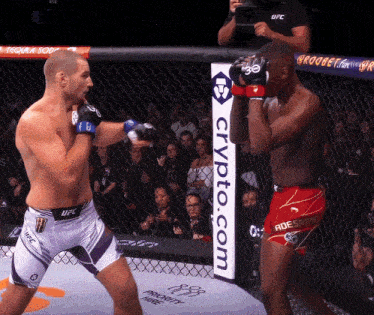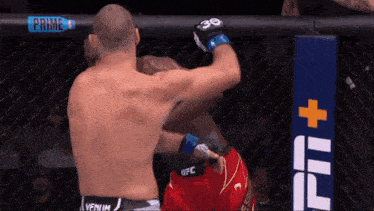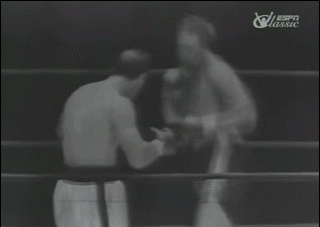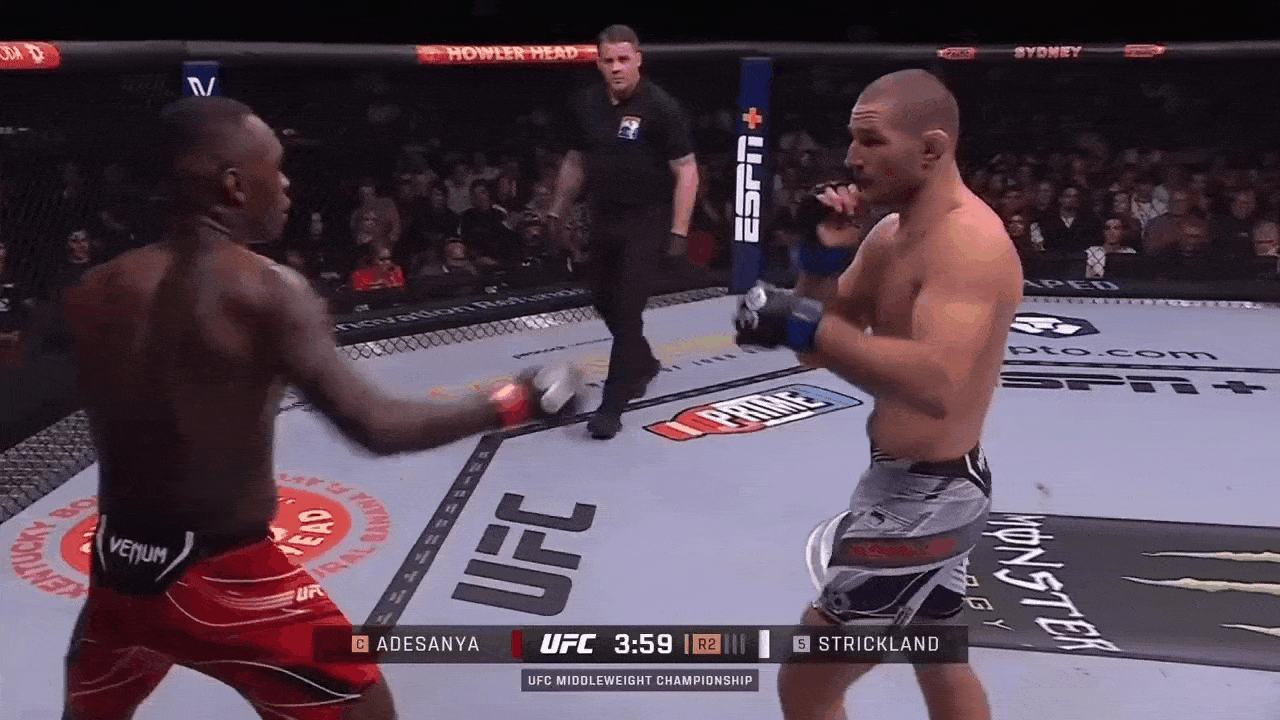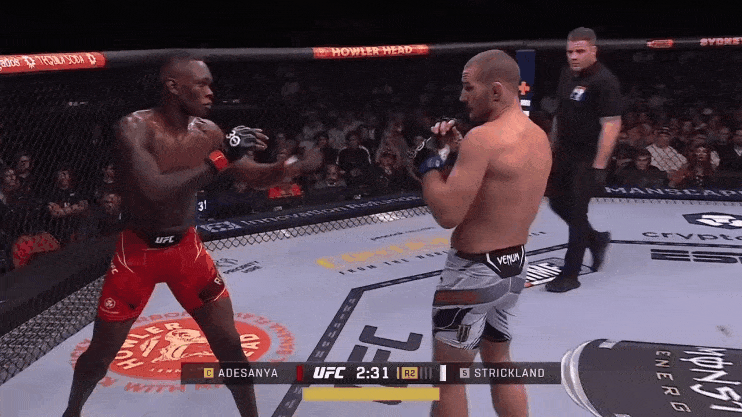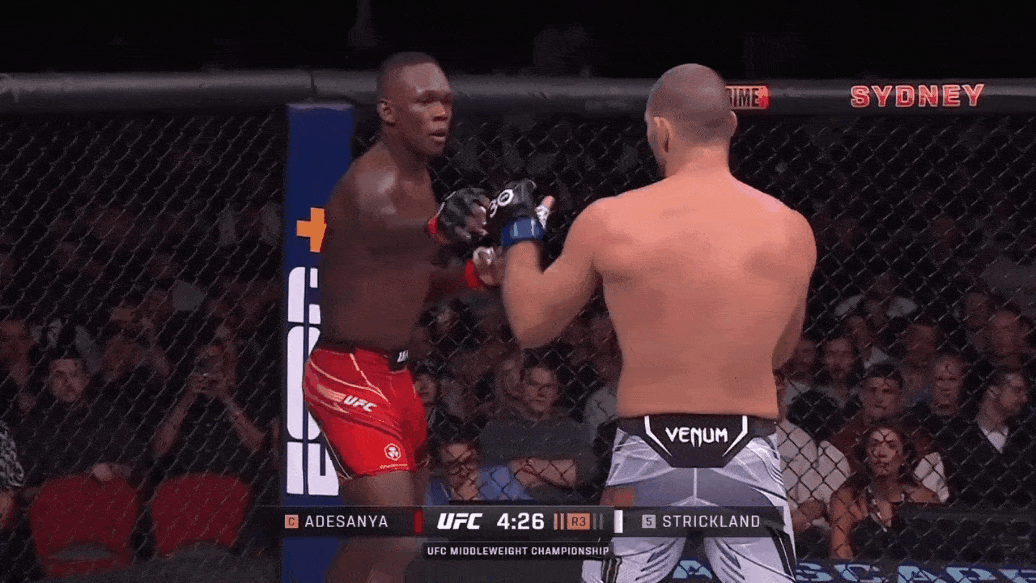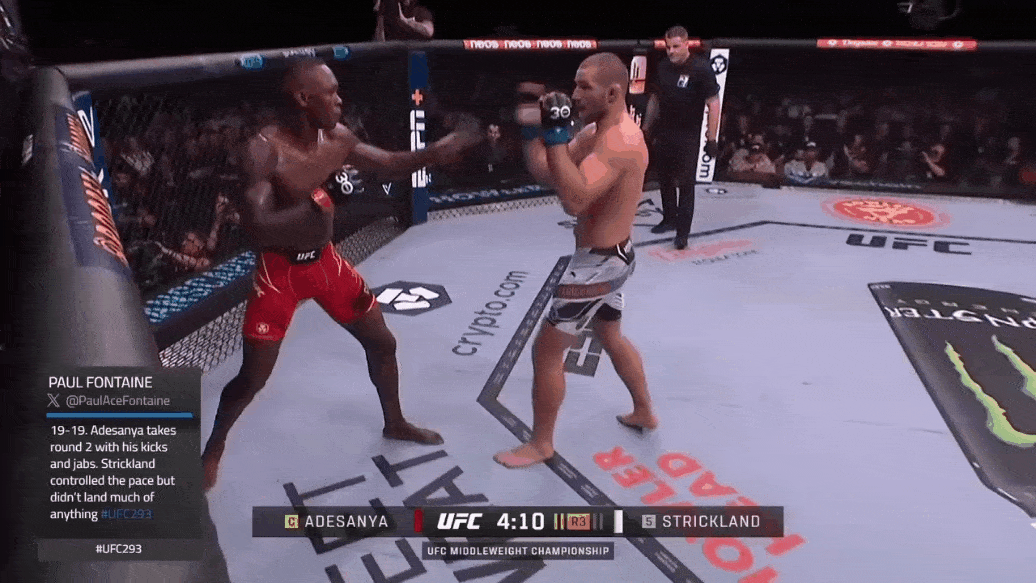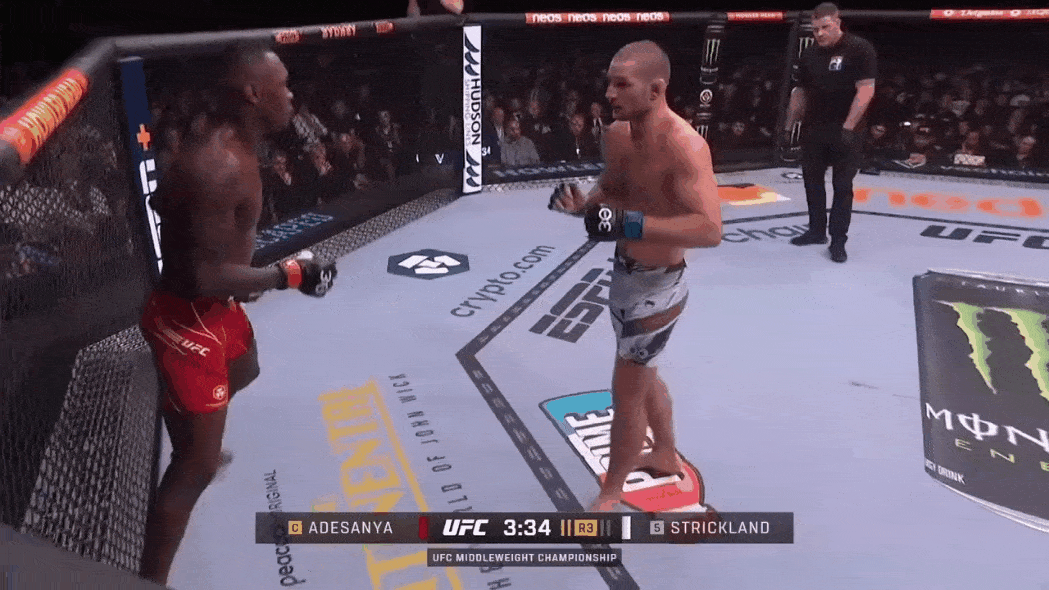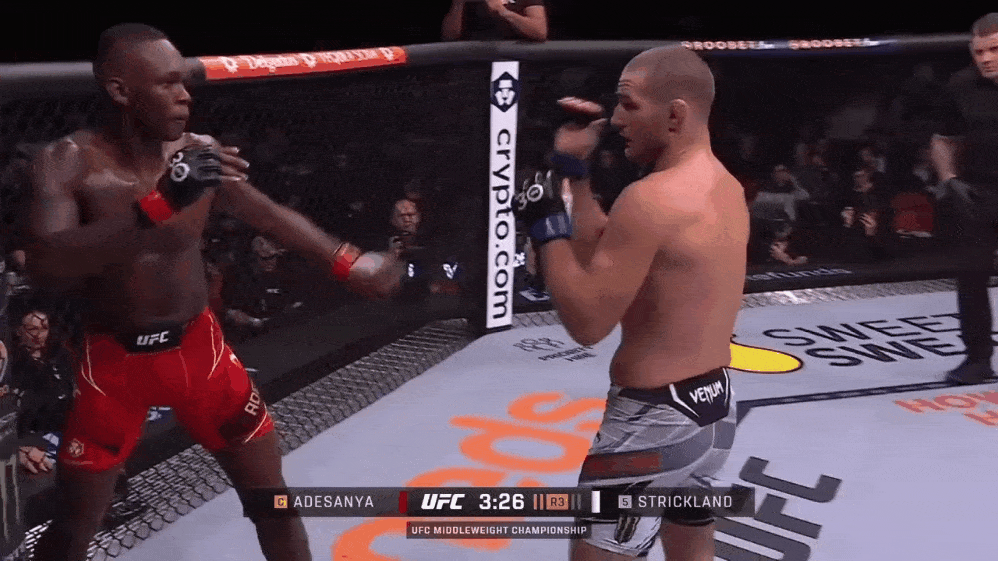Two months ago, Sean Strickland was picking up his second straight win against the largely unknown Abusupiyan Magomedov, who gassed out after one round of striking at his own pace. That win put him in position to step up when number one contender, Dricus Du Plessis was unable to fight for the UFC Middleweight title due to a foot injury.
Strickland was walking into a title shot that he really didn’t deserve as a +500 underdog. While few expected him to win, Strickland didn’t get the message that he was supposed to lose. Instead he turned in one of the biggest upsets in UFC Championship history. But he didn’t do it with a freak knockout or by stumbling into big, fight-changing moments. He picked Israel Adesanya apart at the seams, taking away all his effective offense and leaving nothing but a defensive shell left. For a fighter who was often mocked for his janky striking technique, especially compared to the composed, slick stylings of Adesanya, it was nothing short of vindication.
To understand how Strickland stripped Adesanya of all his offensive tools, first we need to understand the kind of fighter Adesanya is. Like Anderson Silva before him, Adesanya has been billed as a dangerous counterpuncher who is liable to knock out anyone who steps in on him, but just like Silva, that frame has a very loose relationship to what he actually does in his fights.
Adesanya’s big counter shots come on fighters who are already frustrated and desperate, or so aggressive they’re willing to sacrifice defense and positioning for a chance to hit him. They don’t come on fighters who are boxing their way in with their feet underneath them. His modus operandi is to maintain a distance past his opponent’s jabbing range so they can’t immediately step in to hit him, and frustrate their entries. When his man moves in, he steps back. When they try to take an angle, he switches stance and slides out the side door, often manipulating the entry by controlling a hand to force the opponent to throw on the side he wants to slide away from.
After several minutes of trying to find a clean entry and watching Adesanya slip out unharmed, his opponents will often abandon their positioning and chase. This is when Adesanya is dangerous on the counter. His counter-punches are not scalpels that he uses to slice you up as you jab at him, but blunt instruments that smack you over the head when you get sloppy. His wide, committed left hooks and right hands leave Adesanya in poor position too, often squaring his feet and leaning back at the waist, but the beauty of it is that he mainly uses them when he trusts his opponent to be in even worse position. The two knockdowns in the first Whittaker fight are the perfect example - in both, Adesanya is squared up and leaning back, in position to be hit hard. But Whittaker had been so frustrated from his blitzes falling short that he over-committed, squaring himself up and leaving him a mark for the hooks. With Adesanya’s length and lean-back giving him a slight cushion, his hook connected and Whittaker’s fell short once again.
So what happens when opponents remain disciplined and don’t over-pursue? Adesanya can’t box his way out of that, but he kicks them. Hard, often, and right as they step in. He’ll intercept their forward movement with leg and body kicks, then repeat his strafing and sidestepping when they try to counter, only to lead them into more kicks. Adesanya is very well prepared to deal with fighters trying to counter his kicks and has a plethora of funky exits out the side door or backstepping through the opposite stance. Adesanya opponents who applied more measured pressure wouldn’t get hurt too much by his hands, but they would suffer death by a thousand cuts from the precise, scalpel-like kicks.
Most MMA fighters respond to kicks by trying to step in and hit, so it makes sense to invest more in making the exits sound than in tactics to bypass kicking defense. But while he’s very difficult to hit during or after the kicks, Adesanya did not appear to have a plan for when the kicks themselves fail. Enter Sean Strickland.
Strickland typically fights out of a very narrow, upright stance and uses a jittery defensive system involving lots of extended hands to parry and frame. In practice this looks very awkward and can leave a lot of openings for combination punchers to take advantage of the upright posture. But it provides him a significant advantage for kicking defense.
MMA fighters tend to stand in a relatively wide stance with deeply bent knees, as it allows for quick level changes and facilitates power punching, as well as folding over the hips to slip punches. But one of the weaknesses of that stance is that when trying to lift the legs up to defend kicks, it takes much longer to transfer weight from leg to leg. With his narrow stance, Strickland could quickly and easily pick up either of his legs at an instant’s notice, even if his weight was currently parked on that leg.
The utility of narrow stances for kicking defense is a big part of why Muay Thai fighters tend to stand more narrow and upright than MMA fighters. When
Rodtang Jitmuangnon rematched Kaonar P.K.Saenchai after being picked apart with kicks and clinch entries in their first fight, one of the biggest adjustments that allowed him to win was narrowing up on his stance. Rodtang would even advance through kicking range completely square at times, with his feet nearly together so he could lift either up at any time to immediately block or dissuade kicks.
Strickland made excellent use of the defensive capabilities of his stance. He checked kicks off both legs, a feat scarcely seen in MMA. His lead leg would check leg kicks and when Adesanya went to the body, he would either thrust his rear leg forward to check or point the lead leg across in a cross-check. If he miss-timed the check on a body kick, he would rotate his shoulder and hips to close off the open side, mitigating the damage and allowing him to threaten a catch on the leg. When Adesanya tried to hammer the calf, Strickland would fold his leg back at the knee, a classic counter to the calf kick that’s been catching on more as of late. He also remained conscious of the distance and would often pull his lead leg back to make Adesanya’s leg kicks fall short.
But the kick defense wasn’t only a reactive matter, Strickland would constantly pick his lead leg up while stepping in, or march forward lifting both legs up. Marching footwork is a great way to close in on a kicker, as it leaves a near constant barrier of shin between the squishy bits of the body and the opponent’s leg. Every time he raised the leg while walking forward, it signaled that Adesanya would be kicking into a check, and he would often decide to just give ground instead of bothering.
The marching footwork also combines brilliantly with front kicks, and Strickland used a light teep throughout the fight to facilitate his pressure:
The teep wasn’t particularly powerful or threatening, but that wasn’t its purpose. It served to push Adesanya back to the cage where Strickland could work and covered his entries into the pocket. When teeps and round kicks collide, the teep usually wins due to its linear trajectory. Just like jabs slot inside wider hooks, the teep pierces the centerline and threatens to knock a round kicker off balance. The mere act of keeping an active lead-leg teep can dissuade kicks, and when combined with the marching footwork the effect is increased. Every time Strickland picked up a leg, Adesanya had to worry about the check and the teep.
Strickland’s teep also found an important role as an intercepting strike. By keeping the light, flicking teep in front of him as he advanced, Strickland created a barrier preventing Adesanya from stepping in. Several times throughout the fight Adesanya tried to step in with a feint or a punch, only to run into the teep and be forced back.
It wasn’t a skewering strike, but it was enough to halt some of Adesanya’s entries. Later in the fight Strickland started punching off the intercepting teep, taking advantage of the brief moment where Adesanya’s momentum stopped and he was stood in punching range. The teep works similar to the jab as an intercepting strike, but with a distinct advantage; the jab attacks the head which can easily slip, bob, and weave, so opponents can get inside, outisde, or underneath it and continue closing distance. But the teep attacks center mass. The body stays put when the head moves, making it much more difficult to walk through a teep.
The excellent kicking defense and constant teep allowed Strickland to walk Adesanya down and put him on the cage over and over, where Adesanya is most vulnerable. Once there was no room behind Adesanya to slide away, Strickland went on the offensive. He did a great job exploiting Adesanya’s handfighting tactics throughout the fight. The handfighting battle is usually a place of comfort for Adesanya as he’s typically longer than his opponents, but Strickland’s reach made it difficult for him to find success there.
Adesanya regularly controls his opponent’s hands to draw out punches that he can circle away from, or to set up powerful rear hands. Strickland mirrored this back to him, covering the lead hand to force Adesanya to throw his rear and slipping outside it. Later in the fight he used it to land his own offense, either pushing the hand down and punching over it while Adesanya had no room to back up, or shooting out a quick straight right when Adesanya tried to cover his hand.
Throughout large stretches of the fight, Strickland had trouble finding clean offense, but Adesanya spent the entire fight unable to land anything with consistency. It was remarkable how few ideas Adesanya seemed to have once Strickland took his kicks away. With Strickland able to defend the kicks, he could apply the type of measured pressure that has historically made Adesanya uncomfortable. But rather than adjusting, Adesanya seemed to be stuck on his usual strategy of kicking and moving to deal with a fighter who won’t throw himself out of position in the pocket.
Adesanya’s boxing has always been more a collection of tricks than sound application of boxing fundamentals, and that really showed once Strickland closed off his kicking game. In his kickboxing career, Adesanya was more of a mid-range hitter, using active forearm frames and shifting setups to needle his foes with combinations. But in MMA, he’s clearly uncomfortable opening up in that range and sticks to one or two-strike pot shots on the outside.
The feints and jab of Adesanya usually compensate for his lack of commited boxing offense, freezing opponents in place for his kicks and allowing him to work short mixups with the jab and lead hook. But whenever he threw out his lead hand, Strickland would parry and lean back, projecting his lead shoulder to cover against right hands. The feints became less effective over time because there was no threat backing them up. A jab feint would cause Strickland to jitter slightly and attempt a parry, and Strickland would continue moving forward. If the feint was turned into a real punch, he would just pull back to make it fall short, then resume his pressure.
One reliable way to get past an opponent with annoying first-layer defense is to committ to combinations, forcing them to deal with multiple threats in the same exchange that play off each other. But Adesanya has never been too comfortable committing to boxing combos in MMA. What was more conspicuous was his complete inability to put his punches together with his kicks in combination.
Every time Adesanya tossed out a couple half-committed punches, or feinted into a big shot, he put Strickland into a position that left him wide open for a kick that never came. Adesanya would kick actively when Strickland had his weight set to pick either leg up into a check, but as soon as he forced Strickland to lean his head back over the rear foot and commit his weight, making it nearly impossible to check a leg kick, he stopped or went up to the head.
There were several times Adesanya feinted Strickland into a position where he could kick with impunity, then actually waited for him to resume a strong stance before kicking right into a check. It seemed like an almost pathological refusal to commit to punch-kick combinations even though there was no threat coming back at him to dissuade the use of them. But it wasn’t the case that Adesanya fought differently than usual, he’s just never faced an opponent in MMA that could take away the kicks and apply subtle pressure, forcing him to find alternate ways to score with them.
While Strickland’s excellent kick defense was responsible for shutting Adesanya down initially, it’s difficult for me to read Adesanya’s inability to adjust his kicking tactics as anything but a strong indictment of his depth as a kicker. In his kickboxing days he wasn’t a kicking specialist, using them mostly to facilitate his movement and open up his hands. Leaning more on the kicks was an adaptation to an MMA field where fighters tend to operate at longer distances and opponents generally do not have sound defensive responses to kicks. Whenever Adesanya encountered a fighter who tried to pressure without getting overly agressive, he’s been able to kick them largely for free. It was a reminder that kicking tactics in MMA lag far behind the sport’s application of boxing tactics, and that best practices from kicking specialists in sports where the average fighter can defend kicks soundly have not widely caught on.
Conversely, Strickland’s offensive success came largely as a result of his willingness to close distance with committed combinations. While Strickland’s defense involves a lot more waving his arms around, both he and Adesanya have a similar response to the simple jab-jab-straight. They look to give ground and pull their head back from the jabs, before rotating their body inward to roll the straight off their lead shoulder. But while Adesanya largely punched into the shoulder roll, Strickland looked for ways around it.
Continued Here...



